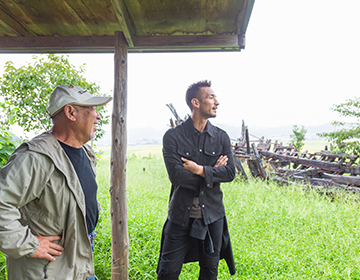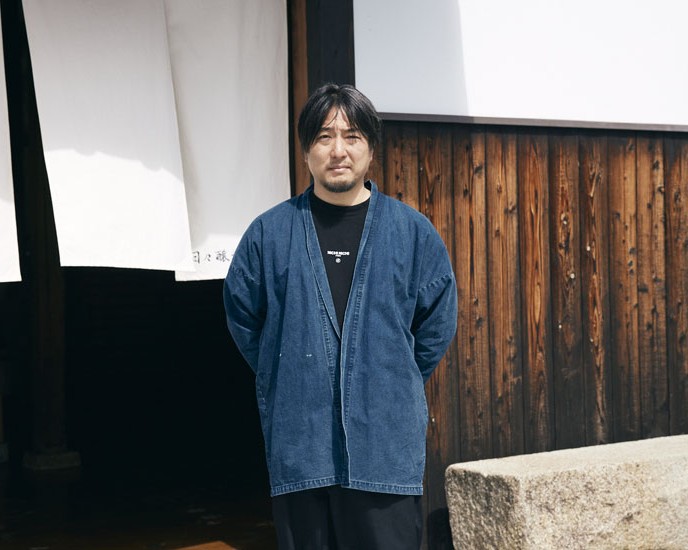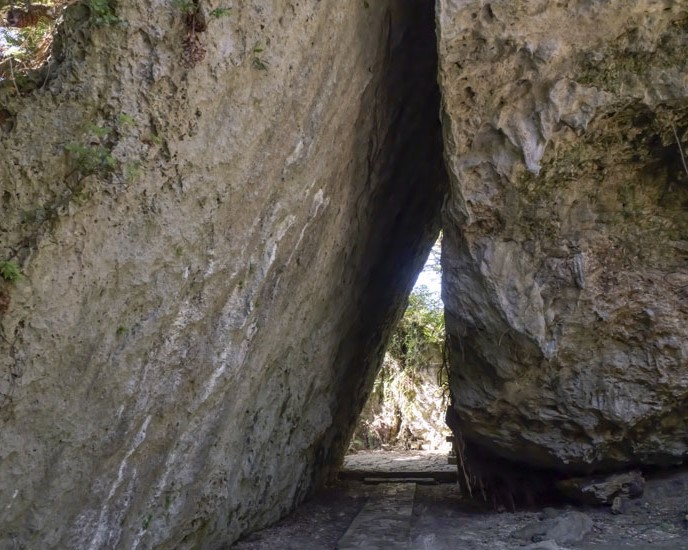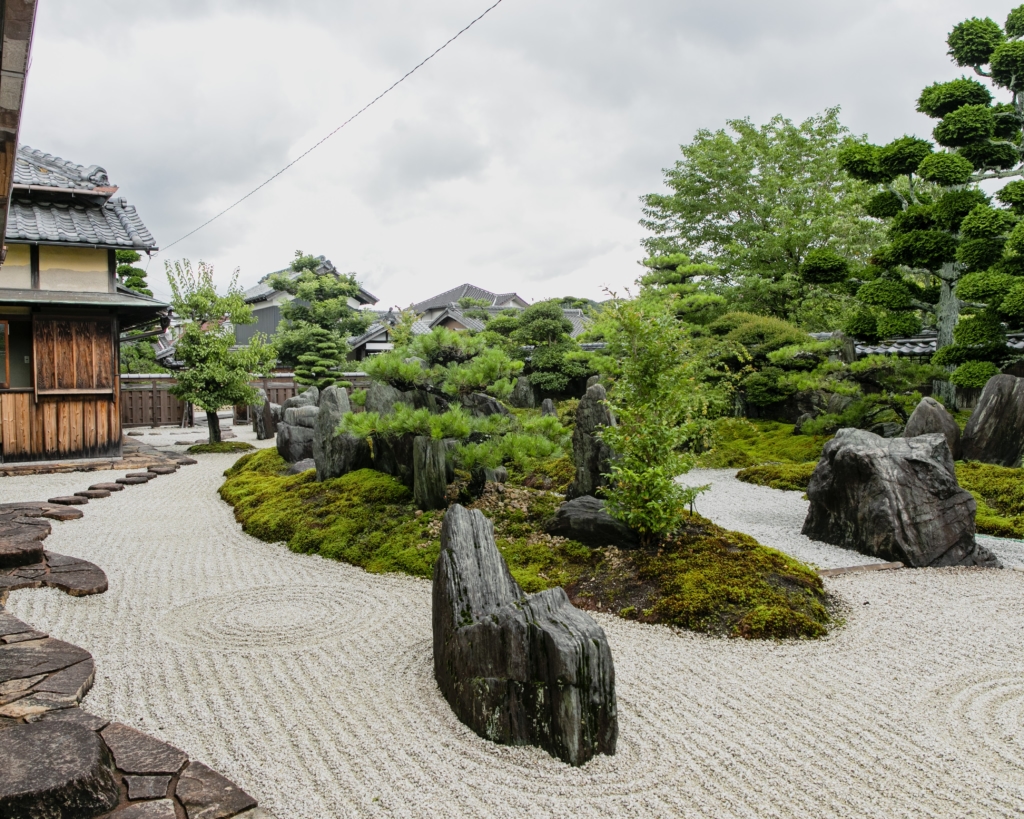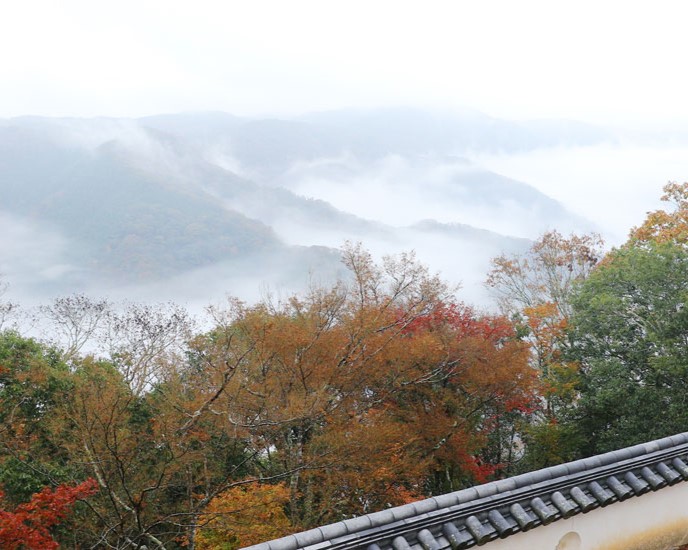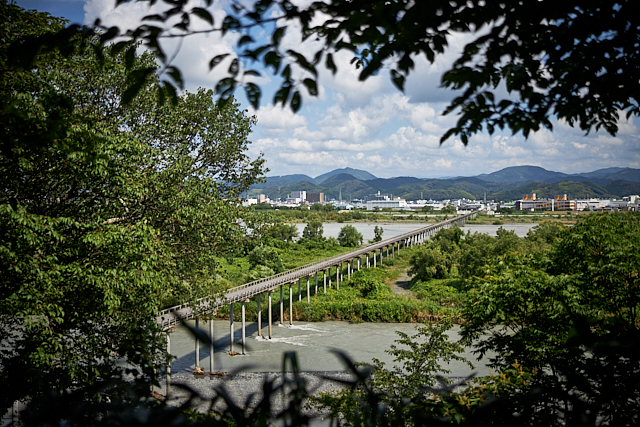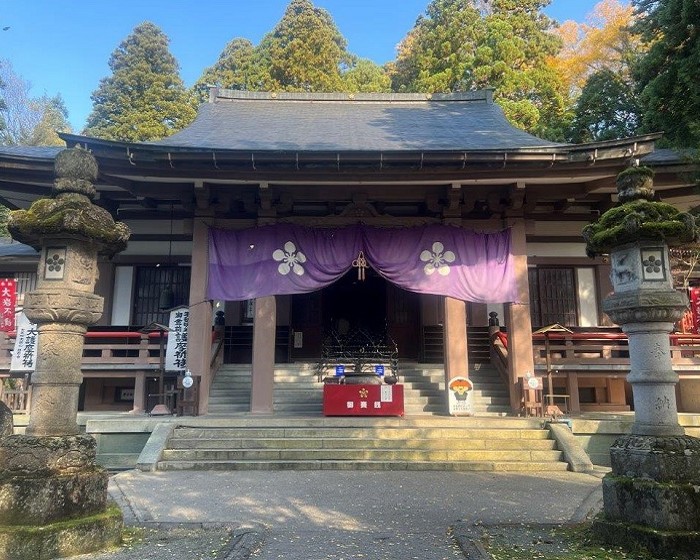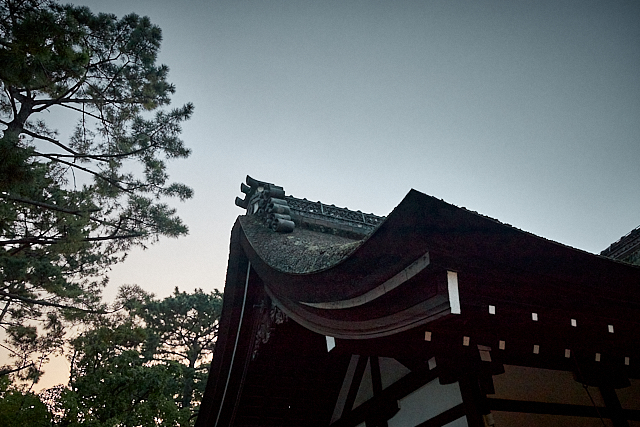TRAVEL– tax –
Many Japanese temples and shrines are traditional wooden structures, and are testament to the fact that Japan is one of the world's prominent "wood" based cultures.
Japan’s craft products, rituals and festive events also have a deep association with buildings of great historical value.
-
 Other Places of Interest Fukushima
Other Places of Interest FukushimaCherry blossom village as far as the eye can see “Iwaki Manbonsakura Project” by Mr. Tadashige Shiga / Iwaki City, Fukushima Prefecture
-
TRAVEL Saga
Mifuneyama Paradise, a symbol of the connection between the people of Saga and nature / Takeo City, Saga Prefecture
-
 SAKE & Kyoto
SAKE & KyotoMatsumoto Hizuhiko of Hibi Brewing Co., Ltd. takes on a new challenge: making nihon-shu using a method that goes beyond the traditional koji-moto method, and opens up a new future for nihon-shu. Kyoto City, Kyoto Prefecture
-
 TRAVEL Okinawa
TRAVEL OkinawaSefa Utaki, a World Heritage Site famous as the most sacred place in the Ryukyu Kingdom
-
 TRAVEL Mie
TRAVEL Mie“Komono Yokoyama Residence Garden” by Mirei Shigemori, which you should visit at least once.
-
 TRAVEL Fukuoka
TRAVEL FukuokaDazaifu Tenmangu Shrine, the head shrine of Tenmangu shrines nationwide, heads toward its 1125th anniversary
-
 TRAVEL Okayama
TRAVEL OkayamaIs the current lord of the castle a cat? Bicchu Matsuyama Castle, a mountain castle in the sky, floating in a sea of clouds
-
 TRAVEL Nagano
TRAVEL NaganoGazing upon the masterpiece of Katsushika Hokusai, Gansho-in Temple in Obuse Town, Nagano Prefecture, known for its chestnuts / Obuse Town, Nagano Prefecture
-
 TRAVEL Shizuoka
TRAVEL ShizuokaMOA Museum of Art, an art spot to refine your senses
-
 TRAVEL Shizuoka
TRAVEL ShizuokaHorai Bridge, the world’s longest wooden pedestrian bridge
-
 TRAVEL Toyama
TRAVEL ToyamaA place of mountain worship that has been popular for a long time. “Oiwasan Nissekiji” is the most powerful spot in Toyama Prefecture.
-
 TRAVEL Osaka
TRAVEL OsakaSumiyoshi Taisha, the headquarter of 2300 Sumiyoshi Shrines in Japan
-
 TRAVEL Miyazaki
TRAVEL MiyazakiAtago-yama (Cape Kasasa)
The romantic myth of “Niniginomikoto and Konohanasakuyahime meeting and being united” remains, and it is called the "sacred place of encounter". The observatory commands a panoramic view of downtown Nobeoka, and was the first in Miyazaki Prefecture to be selected as one of Japan's “Night View Heritage” and the only one to be recognized as one of Japan's "One Hundred Great Lights of the Moon". -
 TRAVEL Miyazaki
TRAVEL MiyazakiNobeoka Castle Ruins
The Nobeoka Castle Ruins is a historical site in Nobeoka City, Miyazaki Prefecture, where Nobeoka Castle was once built. Nobeoka Castle was built in the early Edo period and stood on a hill. Today, the ruins of the castle tower retain the vestiges of the castle and are a popular tourist attraction. From the ruins of the castle tower, a panoramic view of the city of Nobeoka and the surrounding natural landscape can be seen, which, along with the historical background, leaves a deep impression on visitors. The ruins of the castle have a well-maintained walking trail, which visitors can enjoy while experiencing the local history. -
 CRAFT Kyoto
CRAFT KyotoAntique shop “Yumekoubou”
This antique store is located in Gion, Kyoto. At the entrance, an objet d'art made of bamboo created by Chikuunsai Tanabe IV, one of the artists belonging to the shop, evokes the historical atmosphere of Kyoto. In addition to fine antiques, the shop also exhibits works by contemporary artists, offering new values to the public. -
 TRAVEL Ehime
TRAVEL EhimeYuge shrine
This historic shrine in Takayama City, Gifu Prefecture, has long been worshipped as a local guardian deity. The main deity is Yumikazumi-no-mikoto, known as the patron deity of archery and martial arts, and is also revered as a deity of peace and prosperity for the community. In the center of Yumigake Pond, which surrounds the shrine, there is a covered drum bridge over which visitors cross to visit the shrine. The entire grounds of the shrine are considered as a scenic spot, with beautiful natural scenery throughout the four seasons, attracting many visitors and tourists, especially during the cherry blossom and autumn foliage seasons. It continues to be loved by local people as a place with a quiet atmosphere and deep history. -
 FOOD Ehime
FOOD EhimePoeme Sweets Park
This confectionery theme park was created with the idea of "bringing more smiles to families !". The park consists of four areas: a factory area, a shopping area, a freshly baked goods sales area, and a footbath and experience area, where families can spend a pleasant time together. Visitors cannot leave without trying the sweets park's limited products, such as custard-filled cream puffs, baked Mont Blanc with crispy dough and melt-in-your-mouth fresh Mont Blanc. Surrounded by the sweet aroma, this is a unique and happy experience! -
 TRAVEL Ehime
TRAVEL EhimeKamo shrine
This historic shrine is located in Ogaki City, Gifu Prefecture, and is well known to the local people. It was founded long ago and is revered as a local guardian deity. There is a spring that was chosen as the “most delicious water” in a national water-tasting contest, and the spring is known as "God's water". The grounds of the shrine are surrounded by nature in each of the four seasons, which especially attracts visitors during the cherry blossom and fall foliage seasons. The main deities are those responsible for agricultural and commercial prosperity, and the shrine attracts many worshippers as an entity that supports the lives and development of the local people. -
 FOOD Akita
FOOD AkitaTsuchida Farm Milk House
Tsuchida Farm Milk House is a food store located inside Tsuchida Farm. You can enjoy freshly squeezed milk, soft-serve ice cream, sausages, cheese toast, and other fresh foods from the Jersey cows raised on Tsuchida Farm. The milk from Tsuchida Farm's Jersey cows, grown in the sunshine, is rich in iron, calcium, and vitamin A. It tastes mild and has a very fine texture. The sausages are also very juicy. Children and adults alike will enjoy learning about the importance of food. -
 TRAVEL Nagasaki
TRAVEL NagasakiIkitsuki-island
The island has a population of about 6,000. The name “Ikitsuki Island” seems to derive from the history of the Japanese envoys to the Tang Dynasty who traveled a long way and were relieved to finally be able to take a breather. Seafood and fishing are thriving, and there are many tourist attractions where visitors can enjoy the island's historical heritage and culture. Surrounded by the sea and mountains, this is a place where one can enjoy the beauty of nature and local culture. -
 TRAVEL Fukui
TRAVEL FukuiOno-castle
Echizen Ono Castle is located in Ono City, Fukui Prefecture, on top of a 400-meter-high mountain, and is famous as a "castle in the sky”. It is a place where visitors can enjoy beautiful scenery in each of the four seasons, especially the cherry blossoms in spring and the autumn leaves in fall. Visitors can feel the atmosphere of a historical Japanese castle through climbing the castle and walking around the surrounding area, making it a popular tourist spot. -
 FOOD Tottori
FOOD TottoriKawi’s Milk-house
A facility in Tottori Prefecture where visitors can enjoy mainly dairy products. Visitors can taste fresh local dairy products such as fresh white rose milk, handmade ice cream, and cheese. Inside the museum, visitors can enjoy the taste of milk and dairy products while learning about the manufacturing process. It is a place where visitors can enjoy a luxurious taste and relax in a rich natural setting. -
 TRAVEL Tottori
TRAVEL TottoriDaisen Makiba Milk no Sato (“The Home of Milk”)
Experience, play, taste, and enjoy the farm using all five senses. At “Daisen Makiba Milk no Sato,” visitors can interact with nature by cooking with fresh local dairy products, running around on the prairie, learning about cattle breeding, and watching the cows grazing on the pasture. The magnificent Mt. Daisen spreads out in front of you, creating an open space. You can have a fun time with your family and friends, and by the time you return, you will have a valuable experience to learn about dairy farming. -
 TRAVEL Oita
TRAVEL OitaThe Usuki Stone Buddhas
Usuki Sekibutsu (Usuki Stone Buddhas), located in Usuki City, Oita Prefecture, Japan, is a national treasure and the generic name for about 60 polished cliff Buddhas believed to have been created between the Heian and Kamakura periods. These stone Buddhas were carved on tuff cliffs and were considered an important heritage of Buddhist art because of their elaborate carving techniques and expressive power. The Usuki Stone Buddhas are divided into four groups of stone Buddhas, each reflecting a different period and style. Especially famous are the statues of Dainichi Nyorai, Amida Nyorai, and Kongorikishi, which attract visitors with their graceful expressions and intricate carvings down to the smallest detail. These stone Buddhas have maintained their beauty and dignity over the years. The surrounding area has a walking trail and observatory where visitors can enjoy the stone Buddhas along with the scenery of the four seasons. -
 TRAVEL Oita
TRAVEL OitaJoubutsu Iwakage Ruins
Joubutsu Iwakage Ruins are ancient ruins located in Kofu City, Yamanashi Prefecture, where relics from the Jomon period left behind in the shade of rocks have been discovered. The ruins provide valuable clues to the life of the people of the time, especially the large number of earthenware and stone tools that have been excavated. The surrounding natural environment is also rich, and from the walking paths around the ruins, visitors can feel the ancient landscape as well as the historical background. The site has high archaeological value and is an important spot for learning about the history of the region. -
 TRAVEL Nagano
TRAVEL NaganoNaraijuku
Naraijuku was one of the most prospering post-station towns in Kisoji along the Nakasendo Road. The beautiful streets extend over a 1km range, and is a tourist site reminiscent of Japan during the Edo era. -
 TRAVEL Hokkaido
TRAVEL HokkaidoObihiro Shrine
Located in Obihiro, Hokkaido, this is a shrine worshipping Daikoku for rich harvest, happy marriage and prosperity in business. Recently, the shrine was a model for ”Oezo Shrine” in the manga ”Silver Spoon”. -
 TRAVEL Hokkaido
TRAVEL HokkaidoHokkaido Jingu
Shrine located next to Maruyama Park. In 1869, Hokkaido Jingu was made by the order (”Mikotonori”) from the Meiji Emperor to create a ”Kaitaku Sanshin (Three Gods of Pioneering)” to give ”settlers a place of worship”. Covering about 180,000 square meters, it is known for the beautiful cherry blossoms and is frequented by locals. There is a lot of wildlife, and visitors can observe Ezo squirrels, Northern Fox and wild birds. -
 TRAVEL Hokkaido
TRAVEL HokkaidoHakodate Magistrate’s Office
Hakodate was one of the first ports to open to foreigners in Japan. At the end of the Tokugawa period, Hakodate Magistrate’s Office was given the responsibility of providing security for the northern region as well as carrying out foreign negotiations. The spectacular building is the first Western style castle ”Goryokaku” and was dismantled two years after the end of the Hakodate War. After 140 years, the building was reproduced in its entirety, using the highest technology. -
 TRAVEL Hokkaido
TRAVEL HokkaidoGoryokaku Park, Goryokaku Tower
Goryokaku Tower is an observation tower adjacent to Goryokaku, a special historical site in Hakodate, Hokkaido. Goryokaku Park is a star shaped castle and is designated as a Special Historical Site of Japan. It was the site of the Battle of Hakodate, the last battle during the Boshin War. -
 TRAVEL Hokkaido
TRAVEL HokkaidoMatsumae Castle
Matsumae Castle is a Japanese style castle located in Matsumae town inside Oshima Subprefecture Promotion Bureau and was also called Fukuyama Castle. Along with Ishida Castle, it is one of the last castles in Japan, and is also the only Japanese-style castle in Hokkaido. -
 TRAVEL Hokkaido
TRAVEL HokkaidoRyu-un In
The temple was opened in 1625 (Kanei 2). Having survived the Boshin War, it is valuable in that the original buildings from the Edo period still remain standing. The castle consists of the main hall, ”kuri (kitchen)”, ”somon (gate)”, ”shoro (bell tower)” and storage. The main hall and ”kuri” were built in 1842 (Tempo 13) and have been designated Important Cultural Property. -
 TRAVEL Hokkaido
TRAVEL HokkaidoTrappist Monastery
The Trappist Monastery is a monastery of the Strict Cistercian party (Trappist Group), a Catholic sect. In Japan the name usually refers to the Virgin Trappist Monastery at the lighthouse located in Hokkaido Hokutoichi Mitsuishi (Watashima Itsukushi). Females are forbidden to enter. -
 TRAVEL Hokkaido
TRAVEL HokkaidoTrappistine Monastery
Trappistine Monastery is the common name for the ”Temple of the Angel’s Virgin Trappistine” in the outskirts of Hakodate, Hokkaido and is a Trappist Group (Strict Cistercian Group) monastery for women. It is also known as an ”angel’s garden”. It is the first women’s monastery in Japan. Males are forbidden to enter. -
 TRAVEL Hokkaido
TRAVEL HokkaidoMount Hakodate Observation Deck
The night view from the top of Mount Hakodate is a very popular tourist attraction. The best time is 30 minutes after sunset. The view of the town lit with the setting sun gradually transforming into the evening light is very romantic and beautiful. There are 6 ways to get to the top of the mountain, and the main route by ropeway only takes 3 minutes. -
 TRAVEL Hokkaido
TRAVEL HokkaidoKanemori Red Brick Warehouse
Kanemori Red Brick Warehouse is a group of red brick warehouses located in Hakodate City, Hokkaido and is managed and operated by Kanemori Shosen Co., Ltd. Kanemori Shosen was started by Kumajiro Watanabe, a businessman from Oita Prefecture who opened ”Kanemori Yobutsuten” in the Meiji era. Currently it is a sightseeing spot with a shopping mall, bars and restaurants. This area is designated as Important Traditional Buildings and the street view is designated as Hokkaido Heritage. -
 TRAVEL Hokkaido
TRAVEL HokkaidoHakodate St John’s Church
This is the oldest Episcopal Church in Hokkaido. The current building was finished in 1979 (Showa 54). There is a cross engraved on the white wall, and the brown roof that sticks out incorporates the architectural style from the medieval European church, and looks like a cross when viewed from the sky. -
 TRAVEL Hokkaido
TRAVEL HokkaidoHakodate Orthodox Church
Hakodate Orthodox Church was founded when the first Russian consulate in Japan was built in 1858 (Ansei 5). In 1859 (Ansei 6), the first Russian consul, Goshkevich secured the site of the current church for the Russian consulate to be built. The first Russian Orthodox Cathedral in Japan ”Restoration of the Lord” was built in 1860 (Ansei 7). -
 TRAVEL Hokkaido
TRAVEL HokkaidoOld Public Hall of Hakodate Ward
Old Public Hall of Hakodate Ward is located on a hill overlooking the Hakodate Harbor and was built in Meiji 43 (1910) with beautiful bluish grey and yellow contrasting colors in the symmetrical Colonial Style. The Town Hall was one of the most modern buildings at that time and is still quite elegant, especially when viewed from the bottom of the hill. It is considered the landmark of Motomachi. -
 TRAVEL Hokkaido
TRAVEL HokkaidoKoryuji Temple
Koryuji Temple is a temple of the Sotoshu sect located in Hakodate, Hokkaido. It is the oldest temple in Hakodate. The gate and the main hall have a historical feel, and has an impressive presence. -
 TRAVEL Hokkaido
TRAVEL HokkaidoSapporo Clock Tower/ Important Cultural Property
The official name is ”Former Sapporo Agricultural College Military Hall”. The Agricultural College is what is now Hokkaido University, and it was founded in 1876 to cultivate leading pioneers in Hokkaido. Embujo (Clock Tower) was created by recommendation from Dr. Clark in 1878 as a Central Hall for Army Training, Entrance Ceremony and Graduation Ceremony. Since opening, it has witnessed the changes in people’s lives as well as the city of Sapporo -
 TRAVEL Hokkaido
TRAVEL HokkaidoHokkaido Former Government Office/ Important Cultural Property
Hokkaido Former Government Office is a western style brick building designated as an Important Cultural Property. It is also called ”Old Government Office”, ”Hokkaido Red Brick City Hall” and ”Red Brick Building” and has been cherished by the locals to this day. The building is open to the public as Official Documents Library, exhibiting and conserving information related to the development of Hokkaido. A portion of the building is also being used as meeting rooms for the adjacent current City Hall. -
 TRAVEL Aomori
TRAVEL AomoriTowada City Spring Festival
In the spring, 156 cherry trees bloom all at once along a 1.1 km strip of ”Kanchogai Dori”(Koma Kaido), which was chosen to be one of ”Top 100 Streets in Japan”. The whole town is veiled in soft pink hues, and the beauty of the cherry blossoms stand out even more against the green background of 165 pine trees. Many events are held during the Festival including product exhibitions, and lighting of the cherry blossoms at night. -
 TRAVEL Aomori
TRAVEL AomoriHotokegaura
”This is a deed of God made by hands of Oni, not a place of man”. As Keigetsu Omachi read in his poem, Hotokegaura is full of unique and strange looking boulders and rocks. The place, indeed, does not look like it belongs in this world. Enjoy a panoramic view of the 2 km high Hotoke-no-Hama Buddha from the ocean. -
 TRAVEL Aomori
TRAVEL AomoriSannai Maruyama Site
Special Historical Site, ”Sannai Maruyama Site” is one of Japan’s largest Jomon period settlement sites. Studies of the natural environment and the lifestyle of the period are conducted through excavation activities. -
 TRAVEL Aomori
TRAVEL AomoriSaishoin Temple, Five Story Pagoda
The Five Story Pagoda of Saishoin Temple, designated as an Important Cultural Property, was planned by the 3rd clan lord, Nobuyoshi Matsudaira with construction started in 1656. Construction was completed in 1667. The tower is said to be the most beautiful pagoda in the Tohoku region. Although it was built in the Edo era, it retains an ancient style with a very steep shaft, giving the tower an elegant, balanced look. In the first level, only the front has a lattice window with round windows on the other 3 sides. From the second level and above, changes has been made to the design of the windows and structural materials for a different touch. -
 TRAVEL Aomori
TRAVEL AomoriTakayama Inari Shrine
Takayama Inari Shrine is said to be the most powerful miracle-working shrine in Aoyama prefecture, enshrining the god of good harvest, maritime safety and success in business. Many visit for a variety of reasons whether it be agriculture, commercial, industrial, fishery, family well-being, recovery or prevention of illness, protection during travel, warding off evil spirits, etc. The ”Thousand Torii”, which can only be seen here, is a splendor worth visiting. -
 TRAVEL Aomori
TRAVEL AomoriUtou Shrine
It is said that during Emperor Ingyo’s reign, a man named Utou Chunagon Yasukata made the Emperor angry, and was sent to live in Sotogahama Beach as punishment. While there, he had a spiritual dream of ”Takakura Myojin”. He then built a small shrine in the tideland and enshrined the Three Gods of Munakata which later became Utou Shrine. There is a collection of art pieces by Shiko Munakata such as ”Picture of Utou family, parent and child”. -
 TRAVEL Aomori
TRAVEL AomoriHirota Shrine
A prestigious shrine, and the only one to worship the 2nd generation Aomori Chief Councilor, Shindo Shobei Masatsugu Okina who promoted Aomori’s development and progress. The shrine is revered broadly across the country for enshrining a guardian deity warding off calamity, misfortune and disease. -
 TRAVEL Yamagata
TRAVEL YamagataZuihozan Jionji Temple
Legend has it that Emperor Shomu ordered the construction of Jionji Temple in the 18th year of Tenpyo era or 746 AD. All of the historical rulers of this area became devout parishoners of this temple, and Jionji had the largest territorial holdings within the Tohoku area at one time. Currently listed as an Important Cultural Asset, the temple is home to many historically valuable assets. -
 TRAVEL Yamagata
TRAVEL YamagataYamagataken Gokoku Shrine
Yamagataken Gokoku Shrine stands quietly by Mamigasaki River. The shrine was built to comfort the spirits of Satsuma clan warriors who died during the Boshin War in the 2nd year of Meiji (1869), and after that, the spirit of many soldiers who perished in World War II have been enshrined here. This shrine is among the most popular in Yamagata for first prayers of the New Year (”hatsumoude”). -
 TRAVEL Yamagata
TRAVEL YamagataUesugi Family Mausoleum
Uesugi Family Mausoleum is a cemetary which houses the mausoleum for all of Yonezawa clan lords. The tomb for Kenshin, the first lord of the Uesugi family, is located in the furthest plot in the center, followed by Kagekatsu Uesugi all the way to Narisada, the 11th lord. Being a valuable historical asset, it is designated as one of Japan’s historical sites. -
 TRAVEL Iwate
TRAVEL Iwate”Chusonji” – head temple of the Tendai sect in the Tohoku region
Chusonji temple was founded by Jikaku Taishi Ennin in 850. In the 12th century, Kiyohira Fujiwara, who was the lord of the region at the time, ordered a large scale extension of the temple. ”Konjikido”, or “the Golden Hall,” is elaborately decorated with gold leaf inlaid with mother-of-pearl. ”Kyozo” or ”Kyodo” is a storehouse for Buddhist scriptures and artworks from the Heian era which are declared as National Treasure. Also, the architecture is said to depict the ”land of Perfect Bliss” and designated as a World Cultural Heritage in 2011. -
 TRAVEL Iwate
TRAVEL IwateTakkoku-no-iwaya Bishamondo Bettou Takkokuseikouji
”Takkoku-no-Iwaya” is a rock cave where the founder Sakanoue no Tamuramaro commemorated his victory over the local Emishi tribes by dedicating the cave to Bishamonten, making the cave a temple. In 2000, there was a large festival to commemorate the 1200th anniversary of its founding. Despite several fires throughout its history, the temple was rebuilt and standing strong to this day. Visitors can see ”Carved Buddha Face on the Rock”, and a large statue of ”Fudo Myo-o”. -
 TRAVEL Iwate
TRAVEL IwateHachiyozan Tendaiji Temple
It is said that this temple was founded by the monk, Gyoki, under the command of Emperor Shomu in 728 during the Nara period. The main wooden Buddha statue, the standing image of Shokannon (”Keisen bodhisattva”), the main hall, and the Diva gate, ”Nioumon”, are designated as the nation’s Important Cultural Treasures. Within the temple grounds, spring water gushes from the roots of the Katsura trees. Being an ancient temple, Tendaiji attracted the faith of many people for many years, and now stands in quiet beauty. -
 TRAVEL Iwate
TRAVEL IwateFukusenji Temple, Komagi, Matsuzaki-cho, Tono, Iwate
-
 TRAVEL Miyagi
TRAVEL MiyagiShiogama Shrine
Mentioned in an old book of the early Heian period, it was worshipped from ancient times as the guardian of Tohoku and the most important shrine in the country of Mutsu. It is also known for its magnificent cherry trees, with more than 300 trees blossoming in the spring including ”Shiogama cherry blossom” which is a Nationally Designated Natural Monument. -
 TRAVEL Miyagi
TRAVEL MiyagiOsaki Hachimangu Shrine
Built by Masamune Date in 1607. The main palace is designated a National Treasure as the oldest remaining structure of ”Gongen” style from the Azuchi-Momoyama period. Miyagi’s traditional event ”Donto festival” which is held to wish for a year free of illness, attracts many people from within Miyagi. It is worshipped as a shrine closely connected to the lives of the local citizens. -
 TRAVEL Miyagi
TRAVEL MiyagiKanrantei Tea House and Matsushima Museum
During the years of Bunroku, the Noryo-tei building was given to Masamune Date by Hideyoshi Toyotomi at which time it was moved from Fushimi-Momoyama Castle to the clan’s residence in Edo Shinagawa. Then the 2nd lord of the clan, Tadamune Date, moved it to its current location without altering a single tree or stone. It is now open to the public, and one can sit and have a bowl of matcha tea while enjoying the view over Matsushima Bay, or view the valuable collection of items owned by the Date family. -
 TRAVEL Miyagi
TRAVEL MiyagiZuihoden
A mausoleum built in 1636, in accordance with the will of Lord Masamune Date, the first feudal lord of Sendai clan who died at the age of 70. Although it burned down during the war, it was reconstructed and renovated, and one can view the gorgeous building, just as it was originally. -
 TRAVEL Fukushima
TRAVEL FukushimaMount Bandaisan, Enichiji Temple, Golden Pavilion
Enichiji Temple is the oldest known temple in the Tohoku region. The main building ”Kondo”(Golden Pavilion) was restored in 2008. Visitors can learn about the Buddhist culture rooted in the history of Aizu in the adjacent archives. -
 TRAVEL Fukushima
TRAVEL FukushimaKobiragata Tenmangū Shrine
This shrine is located on the shores of Lake Inawashiro, and is known as the third largest shrine in Japan. The shrine deifies god of learning Michizane Sugawara, and students visit from all over the country as they prepare for entrance exams. -
 TRAVEL Tokyo
TRAVEL TokyoYushima Tenmangu
Built in 456 to worship Ameno Tajikarao No Mikoto, it began to attract academics and writers to worship the god of learning when Lord Michimasa Sugawara was also enshrined in 1355. The shrine is known widely as ”Yushima Tenjin” and many people visit to pray for success in academics. -
 TRAVEL Tokyo
TRAVEL TokyoKanda Myojin
Established in 730 when Oonamuchinomikoto was enshrined. Its official name is ”Kanda Jinja”. From ancient times, it attracted followers from 108 towns including Kanda, Nihonbashi, Akihabara and Otemachi as the main god protecting the traditions of Edo culture. Every other year in May, the ”Kanda Matsuri” festival is held and is considered one of the three great festivals of Edo. -
 TRAVEL Tokyo
TRAVEL TokyoJyodoshu, Daihonzan Zojoji
One of the seven greatest temples of the Jodoshu sect of Buddhism, the official name is ”Sanenzan Koudoin Zoujoji”. Built in 1393, it attracted a lot of followers as the resting place of the Tokugawa family. The ”Sankai Datsumon ?” facing the main street was built in 1622, and is designated as the nation’s Important Cultural Property as a wooden structure from the early Edo period. -
 TRAVEL Tokyo
TRAVEL TokyoOgamiyama Shrine
The shrine began when Lord Tadayori Ogasawara, who discovered the Ogasawara Islands, created the base and pillar of ”Dai Nippon Tenshoukou Taijingu”. The entire area around Ogami Mountain is maintained as Ogamiyama Park, and the entire Futami Bay can be viewed from the plaza near the shrine. -
 TRAVEL Tokyo
TRAVEL TokyoKishimojindo
"Kishimojin”, the goddess for safe birth and child rearing, is enshrined here. Its roots date back to the Muromachi period when the original statue was discovered from a well near the current Mejirodai, Bunkyo area. In 1964, it was designated as Tangible Cultural Property of Tokyo. -
 TRAVEL Kanagawa
TRAVEL KanagawaKenchoji
Kenchoji is the main Zen temple of Rinzai, Kenchoji School. Its formal name is ”Kofukusan Kencho-Kokoku-zenji. With a garden reminiscent of the Kamakura era when the temple was first opened, ”Kenchoji Keidai” is a designated Historic Site and Place of Scenic Beauty. -
 TRAVEL Kanagawa
TRAVEL KanagawaThe Great Buddha and Kotoku-in
Hase-dera, or formally ”Taiizan Kotokuin Shojosenji”, is a Jodoshu Buddhist temple and is known for its ”Great Buddha”, a statue of Amida Buddha. It is said that construction of the Great Buddha began as early as 1252. The statue survived numerous disasters and changing times, and the temple grounds is a designated Historic Site, ”Kamakura Daibutsuden Site” -
 TRAVEL Kanagawa
TRAVEL KanagawaDaiyuzan Saijoji of Soto Zen Buddhism
Zen master Ryoanemyo founded this temple in 1394. The temple is known for the 4000 schools that belong to this sect, and its ”dojo” is believed to have miraculous powers. Legend has it that a monk named Douryou became a ”tengu” and hid in the mountain, and many visitors dedicate ”geta” to the the temple. -
 TRAVEL Kanagawa
TRAVEL KanagawaDaizozan Sugimotodera
Sugimoto-dera was built in 734 by the order of Empress Komei, the wife of Emperor Shomu, and an eleven-faced Kannon was enshrined in this temple. Dedicated to three statues of eleven-faced Kannon, it is the first check-in point (”fudasho”) for both ”Bando Sanjusankasho” and ”Kamakura Sanjusankasho”. -
 TRAVEL Tokyo
TRAVEL TokyoKuzuryu Shrine
A shrine believed to enshrine Kuzuryu Ookami as the guardian god by priest Suumamori Ono Nakamura who founded this area. Every year in September during the big festival, Intangible Cultural Properties such as ”Daikagura”, ”Three Lions” and ”Bakamen Bayashi” are dedicated. Near the shrine. there is a ”Waterfall of Kuzuryu” which is used for purification rituals throughout the year. -
 TRAVEL Kanagawa
TRAVEL KanagawaHakone Jinja
Hakone Jinja was founded as a place of mountain worship long ago. It is dedicated to ”Hakone Okami”, the gods of the mountains. There also is Kuzuryu Jinja which enshrines ”Kuzuryu Okami”, the guardian god of Ashinoko Lake. With the addition of a newly constructed shrine, Hakone Jinja has become a popular tourist site. -
 TRAVEL Kanagawa
TRAVEL KanagawaTsurugaoka Hachimangu
Tsurugaoka Hachimangu was initially built on Yuigahama Beach to worship Iwashimizu Hachimangu of Kyoto. It eventually became a spiritual foundation for the samurai class during the Kamakura era. There are numerous Shinto rituals still held at this shrine such as ”Yabusame” and ”Buraku”. -
 TRAVEL Ibaraki
TRAVEL IbarakiHomanzan, Ichijoin
This temple was created in 1386 for the Chisan sect of Shingon Buddhism. ”Bishamondo” was built as a prayer house for Emperor Kanmu, and has a history of about 1000 years. The temple is filled with colorful flowers and is famous for its unique ”omikuji”. -
 TRAVEL Tochigi
TRAVEL TochigiNikkosan Rinno-Ji Temple
Originates from Shihonryu-ji Temple which was started by Shodo-shonin (Saint-Shodo) in the Nara period. In the Edo period, ”Taiyu-in” was built to enshrine Iemitsu Tokugawa, the third ”shogun”. The main hall and ”Sanbutsu-do” were first built in Heian-period. The present buildings were rebuilt in 1645, and is now undergoing ”the Great Heisei Repair” as the oldest wooden structure in east Japan. It is designated as a World Heritage, together with Toshogu Shrine and Nikko Futarasan Shrine. -
 TRAVEL Tochigi
TRAVEL TochigiToshogu Shrine
Enshrines Ieyasu Tokugawa as ”Toshodaigongen” to wish peace throughout Japan. In the era of Iemitsu Tokugawa, the third ”Shogun”, it went through ”the Great Kan-ei Reconstruction”, and the magnificent shrines and pavilions were built as we see them today. It is designated as a World Heritage as a part of ”Temples and Shrines of Nikko”. -
 TRAVEL Tochigi
TRAVEL TochigiNikko Futarasan Shrine
A shrine closely associated with the nature of Nikko. Enshrines the gods of Mount Nantai (Mount Futara), Mount Nyoho and Mount Taro. It consists of the main shrine ’”Gohonsha”, ”Chugoshi” shrine by Lake Chuzenji, and ”Okumiya”shrine on the summit of Mount Nantai. -
 TRAVEL Saitama
TRAVEL SaitamaMusashi Ichinomiya Hikawa Jinja Shrine
The headquarter of about 280 Hikawa Jinja Shrines all over the country of ”Musashinokuni”. It was hailed as ”Oinaru Miyai” (a great shrine), the origin of the name of the city ”Omiya”. -
 TRAVEL Saitama
TRAVEL SaitamaSenba Toshogu Shrine
Toshogu Shrine enshrines Ieyasu Tokugawa. Richly colored pavilion still remains today. -
 TRAVEL Niigata
TRAVEL NiigataYahiko Jinja
”Yahiko Jinja” is the Ichinomiya Shrine of Echigo area, which rests at the foot of Mount Yahiko. It has been worshipped and called ”Oyahiko-sama” since ancient times by the locals. Its enshrined god Ameno-kagoyama-mikoto is said to have taught people how to fish, produce salt, farm, and brew sake. -
 TRAVEL Chiba
TRAVEL ChibaDaihonzan Naritasan Shinshoji Temple
Also known as ”Narita Fudo”, the temple enshrines ”Fudo Myoo” as the main god and remains to attract a lot of followers. Belongs to the Shingon sect Chisan school of Buddhism. -
 TRAVEL Yamanashi
TRAVEL YamanashiGuardian of Kai-country ”Takeda-jinja Shrine”
A shrine founded on the grounds of ”Tsutsujigasaki no yakata”, where three generations of the Takeda warlord Family - Nobutora, Shingen, and Katsuyori - actually lived. -
 TRAVEL Yamanashi
TRAVEL YamanashiAncient temple of Shingon sect ”Kashiosan Daizenji Temple”
Enshrines the seated statue of ”Yakushi-Nyorai”(Buddha of medicine and healing) with a cluster of grapes in its hands. The temple has come to be called ”the birthplace of Koshu Grape”. -
 TRAVEL Yamanashi
TRAVEL YamanashiAokigahara Jukai
Called ”the ocean of trees of Fuji”, it is said that once you step into it, you will never be able to come out. Designated as a National Natural Treasure, public access is available in certain areas. -
 TRAVEL Yamanashi
TRAVEL Yamanashi”Minobusan Kuonji Temple” the head temple of Nichiren Sect
Nichiren Shonin (Saint Nishiren) spent his last years here, and the temple was built as his grave in accordance to his will. It still remains to be a center of faith for its followers. -
 TRAVEL Shizuoka
TRAVEL ShizuokaFukuchizan ”Shuzenji Temple”
An ancient temple of Izu, also described in the Kabuki play ”Shuzenji Monogatari”(The Tale of Shuzenji) -
 TRAVEL Shizuoka
TRAVEL ShizuokaOkuni Jinja
The shrine has 1400 years of history that passes down the twelve ritual dances of ”juni dan buraku” -
 TRAVEL Shizuoka
TRAVEL ShizuokaFujisan Hongu Sengen Taisha
Enshrines Asama-no-Ohkami, who is said to have pacified the mountain gods of Mt. Fuji. -
 TRAVEL Shizuoka
TRAVEL ShizuokaKunozan Toshogu Shrine
A National Treasure that enshrines the First Shogun Ieyasu Tokugawa -
 TRAVEL Gunma
TRAVEL GunmaShorinzan Darumaji
Many visitors come to purchase”Daruma dolls” to the ”Daruma Market” every year. The temple continues to convey the teachings of Bodhidharma. -
 TRAVEL Gunma
TRAVEL GunmaIchinomiya Nukisaki Jinja
A Shinto shrine built 1400 years ago known for its unique layout where the main shrine is located down the stairs from the entrance. -
 TRAVEL Gunma
TRAVEL GunmaSerada Toshogu
Out of the 600 ”Toshogu” shrines all over the country, Serada Toshogu has the oldest connection to the Tokugawa clan. -
 TRAVEL Nagano
TRAVEL NaganoTogakushi Shrine
Reminiscent of ”shugendo”, the shrine honors the gods of water and good harvest. -
 TRAVEL Aichi
TRAVEL AichiDaijuji
The final location the Tokugawa lord escaped to during ”The Battle of Okehazama”. The resting place for the Tokugawa and Matsudaira families -
 TRAVEL Aichi
TRAVEL AichiYamamotoya Honten Nagoya Interchange South Shop
Nagoya’s piping hot specialty dish. ”Miso-nikomi-udon noodle” specialty shop -
 TRAVEL Gifu
TRAVEL Gifu”Gifu Great Buddha (Daibutsu) at Shohoji”
Gifu Great Buddha is also known as ”basket Buddha”, the largest dry lacquered Buddha made from bamboo, ”washi-paper” and lacquer. -
 TRAVEL Ishikawa
TRAVEL IshikawaOyama Shrine (Kaganokuni Kanazawa)
Elegant gates adorn the entryway to the shrine dedicated to Toshiie Maeda and his legal wife Matsu, and has become a symbol of Kanazawa -
 TRAVEL Ishikawa
TRAVEL IshikawaSojiji Soin
Old Soto sect temple founded by Keizan Jokin -
 TRAVEL Fukui
TRAVEL FukuiKehi Jingu Shrine
Dedicated to Izasawakenomikoto, the shrine is said to ensure water safety, bumper year for fishing and bountiful crops for the Hokuriku region.



